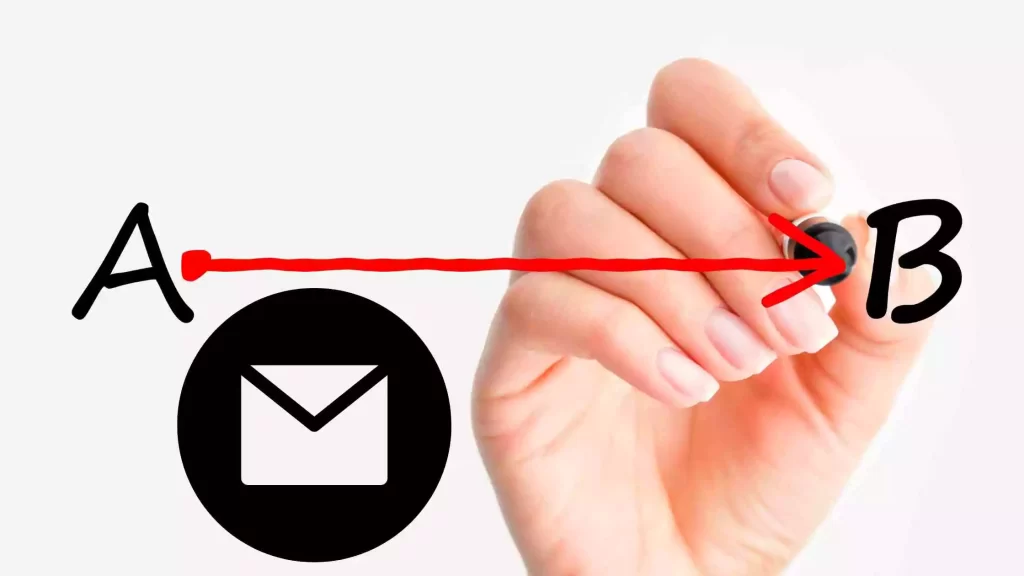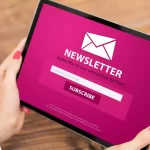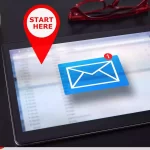A/B testing helps you get the most out of your newsletters. What are split tests, why are they so popular, and how can they help you increase your marketing? You will learn everything in the text – including step-by-step directions and detailed examples.
A/B Testing: What is it?
A/B testing, or split testing in English, is used in marketing. With its guidance, you will find out which of the two alternatives of a given element performs best.
You may come across it largely in email marketing, but it is also not an exception on websites or banner advertisements.
An email A/B test appears like you divided your audience in half. Then send each of them a slightly different newsletter. It might have different content, a different color of the CTA button, or maybe a new sender.
You will then examine whether the form of the newsletter reaps better results. And VOILA, you can take your marketing to the next level!
Tip: Want great advice on newsletters? Please read our article in The Perfect Newsletter.
What are A/B testing newsletters useful for?
Thanks to A/B tests, you can:
- Customize the newsletter for your target group
- Increase open rate
- Raise the click-through rate
- Boost conversions
You will fine-tune your newsletters to the last detail, so both you (since you improve sales) and your clients (because they receive the newsletters they desire) will be happy.
Tip: Do you want your client to receive your emails? Please read our guide on How to Prevent Email from Going to Spam.
What can you A/B test?
The greatest email is not the one you enjoy but the one your target audience loves the most and generates the most likes, clicks, or conversions (depending on your aim).
In brief, you have to create a perfect newsletter in which all the parts are as precise as they should be.
There are many various elements that might impact consumers, from the length of the subject line to the location of the visual element to the usage of emoticons.
You can test virtually anything you want. But if you want to get to the point fast and not waste your valuable time, concentrate largely on these elements:
Subject
The topic matters if consumers open the email at all. Therefore, you should give it due effort.
You’ll find lots of advice all over the internet on how to write the finest topic in the world, but the fact is that every audience is different, and there is no one-size-fits-all guidance. A/B testing can help you identify the finest content that is personalized to your subscribers. Test:
- The length of the subject. In most circumstances, the shorter, the better. But your audience may be an exception. Try it out.
- Use of emoticons. Will smileys in the subject line capture attention and engage your consumers or turn them away?
- Using numbers. For most individuals, numbers in an item function like a magnet. Five sure ideas on how to … or 10 of the most beautiful sites you must visit. Try the version with a number and the version without a number.
- Interrogative sentence. Do interrogative or declarative phrases engage your consumers more? Or even commanding?
- Communication style. You may already know how your customers communicate, which slang terminology they use and whether they want to chat with you. Or maybe you need to find out – with an A/B test.
Date and time of dispatch
The day and hour when the customer’s email arrives play a more crucial function than it might seem.
Imagine, for example, a manager who gets a great business proposition – but on a Friday night.
He merely skims through the email and tells himself he’ll return to it on Monday am when he’s back at work. But guess what? He won’t recall any email on Monday.
Or, on the other, picture a guy who is at work when he gets a newsletter advertising new clothing in his favorite shop.
He can’t look at clothing during work hours, so he postpones the newsletter. But just as in the case of the manager, there will be no later this time either.
The basic guideline, which also comes from our two instances, is:
B2B emails should be sent during business hours,
B2C should be sent outside.
But it probably won’t surprise you that your audience may feel the opposite. And that’s why A/B testing comes on the scene again. Try if:
- A Workday or weekend is better
- It is better to send emails in the morning or the evening
- It is preferable to write within or outside of working hours
Sender
People are more inclined to open an email from someone they know. And also from someone they recall giving them the approval to deliver newsletters. (Be aware GDPR in emailing is a known science .) Try multiple versions of the sender and see which one works best. You may try, for example:
- Firm name (XY)
- Name of the company with a description of what it does (XY – smart vacuum cleaners)
- Name and position of the owner (John Tyson, CEO of the XY firm)
- Owner’s first name (John from XY).
By picking the sender, you determine the intended tone of the email in advance. And above all, you determine whether clients identify the newsletter with your firm or whether they instinctively place it in spam and send it directly to the trash.
Length of the newsletter
When it comes to business blogs, SEO regulations are clear: posts longer than 2,000 words perform better than shorter ones.
But what about newsletters? This time too, it relies on the audience u. In certain circumstances, you score with a lengthy paragraph that goes into depth and details the offer in full. Other times, you’ll conjure up tenfold conversions with only a few phrases.
Create two copies of the same newsletter that have the same topic, subject, sender, and other features but vary in length. Then watch which performs better.
CTA button
A CTA button is a graphically distinguished field that instructs customers what to do: buy, book, or read on.
This little button packs a lot of power. However, how well it will work depends on its color, length, size, and specific text.
Also, test whether it works better with your customers if the newsletter contains one prominent CTA button or if it has several.
And find out whether it is more convenient for you to set the button at the beginning, at the conclusion, or in the middle of the newsletter.
Graphics
There is no need to hypothesize that images are important: buyers spend 10% more time looking at graphics than reading text on the web.
Therefore, the split test should not overlook the visual page of the newsletter either. Find the best with it:
- Font color
- Background color
- Introductory image
- Photo style
- Other graphic components
Attention: Test only one element at a time
Whichever element you decide to A/B test, the most important thing is only to test one at a time.
If you send one variation of an email with a pink CTA button at the beginning and another variation with a blue CTA button at the end, how do you know which winning variation owes its success?
Is it the color or the button placement? Therefore, everything except the examined element must be identical in both instances of the email.
What requirements must a successful A/B test meet?
- Apply the test to two or more groups of contacts that are nearly the same size.
- Each group is big enough – of course, the larger the number of receivers, the more meaningful the test result will be. Ideally, you should acquire at least 50 clicks or 50 openings to remove the chance significantly. If you wish to assess the open rate, one group should reach roughly 1000 contacts.
- Recipients are divided into groups randomly – thanks to emailing programs, you have this solved.
- You send the email to the tested groups at the same time.
- You are testing a type of email that you send often, and you already have statistics available to compare the results with.
How to A/B test your newsletter step by step
A/B testing is not rocket science. Four simple steps are enough to perform a split test successfully:
1. Select the element to test
What is the purpose of an A/B test? What do you want to find out, and what do you want to achieve? Pick the most important thing to you and choose the element to test accordingly.
Is the number of people who open the email important to you? Then focus on A/B testing the subject line and gradually try variations with different lengths, styles, and emoticons. Wondering how to increase clicks? Take CTA buttons to the show and test their ideal number, location, color, and text.
2. Create an audience
A/B testing only makes sense if you have a large enough audience. Otherwise, there will be statistical deviations, and the results won’t tell you anything anyway. It is ideal if you have at least 2,000 recipients in reserve for your split test.
Another factor is if the provided audience is at anyway attractive to you. If you want to test how many sewists will open an email advertising new textiles, sending a split test to blacksmiths makes no sense. Therefore, design an audience group that is both broad enough and relevant at the same time – given the purpose of the provided A/B test.
3. Perform a split test
Once you are clear on the purpose of the A/B test, the tested part, and the audience, the execution itself is a piece of cake. Just click through the mailing tools that will walk you through the full A/B test. For example, you can establish split testing with Mailchimp:
4. Evaluate the A/B test
After a few days, launch the mailing tool again and analyze the split test. It’s not complex – the program will show you the findings by itself. Just hover over the delivered newsletter and see the report.
Sometimes, errors occur, and particularly if the discrepancies between the results are relatively modest, it is advisable to repeat the test.
Which tools can you use?
A/B testing has been so effective in practice that most email systems already support it. You may find it, for example, in Mailchimp and Ecomail, but also in many others.
There are occasions when you can test many components at once
There are instances when you’re rushed for time or don’t want to deal with A/B testing. In such a situation, multivariate testing often termed A/B/N testing (where you replace N with a number that represents the number of tested versions), might come into play.
But such examinations are less accurate, need more sophisticated knowledge, and are more challenging to analyze. In addition, substantially bigger audiences are required for them to avoid major statistical variances.
Before you start A/B testing
What are the most typical A/B testing mistakes?
No scientist dropped from the sky. Thus, it’s totally common for individuals to make errors while performing A/B testing. Which errors are the most prevalent, and should you avoid them?
- Testing variations in varied situations – offer the variants fair conditions and mail them at the same time, a few days apart at most.
- Too short/long testing time – give people time to get to the email and have an opportunity to answer.
- Testing tiny modifications – remember that even two nearly similar emails might have different outcomes in A/B testing. Therefore, test improvements that are visible and will take you in the correct way to increase conversions.
- Testing drastic changes – if you start testing multiple modifications at once, you won’t have a chance to find out which ones lead to success. Even in this instance, everything applies in moderation.
- Testing that, in the end, will not offer any value –it frequently occurs that organizations start testing a topic for the newsletter and assess that option B is superior. Still, then they can no longer use it. They will no longer send the same newsletter. Before testing, always bear in mind what you want to accomplish and how you will work with the gathered information.
A/B testing is a simple and efficient approach to producing successful email marketing. In order to assess the tests relevantly, test just one element for the content of the email, and potentially also one on which the open rate relies-such as the topic of the message, the name of the sender or the time of sending.
Do you have expertise with A/B testing yourself? What tests gave you the greatest results? We would be pleased if you shared with us





